|
|
Butterflies - Brush-footed -
More Information
|
|
|
|
~ Click on any image for an enlargement - scrollable if it is too big for browser window ~
|
|
Kingdom: Animalia
Phylum: Arthropoda
Subphylum: Hexapoda
Class: Insecta Pterygota
Order: Lepidoptera
Family: Brush-footed Nymphalidae
Subfamilies: Admirals and Relatives Limenitidinae - Emperors Apaturinae - Longwings Heliconiinae - Milkweed Butterflies Danainae - Satyrs and Wood-Nymphs Satyrinae - True Brushfoots Nymphalinae
Family Description: The Nymphalidae are members of the Superfamily Papilionoidea, the true butterflies. Distributed worldwide, butterflies of this family are especially rich in the tropics. They are highly variable, and there are more species in this family than in any other. Adults vary in size from small to large, and their front legs are reduced, unable to be used for walking. Wing shape is also highly variable: some species have irregular margins (anglewings and commas), and others have long taillike projections (daggerwings). Browns, oranges, yellows, and blacks are frequent colors, while iridescent colors such as purples and blues are rare. Adults of some groups are the longest-lived butterflies, surviving 6-11 months. Adult feeding behavior depends on the species, where some groups primarily seek flower nectar while others only feed on sap flows, rotting fruit, dung, or animal carcasses. Males exhibit perching and patrolling behaviors when seeking mates. Egg-laying varies widely, as some species lay eggs in clustsers, others in columns, and others singly. Caterpillar appearance and behavior vary widely. Brushfoots overwinter as larvae or adults.
Subfamily Description: Admirals and Relatives (Limenitidinae) are members of the Family Nymphalidae. These admirals and relatives are found on most continents. Adults of most genera are characterized by their flap-and-glide flight. Caterpillar and chrysalis structure defines this group.
Subfamily Description: Emperors (Apaturinae) are members of the Family Nymphalidae. Found worldwide, they are a closely related group. Adults are brightly colored and stout-bodied. They are most closely related to the Charaxinae and Satyrinae subfamilies, as evidenced by their early developmental stages. In North America, they are limited to the genus Asterocampa.
Subfamily Description: Longwings (Heliconiinae) are members of the Family Nymphalidae. They are richest in the tropics, but several genera are prominent in the Northern Hermisphere, including the fritillaries or silverspots and the lesser fritillaries. The adults of several species are distasteful, and many other species mimic the distasteful butterflies of this subfamily. Adults are long-lived, with some as long as six months. Males patrol in search of females. The adults of genus Heliconius are unique in that they intentionally collect pollen in their proboscis and then absorb its proteins.
Subfamily Description: Milkweed butterflies (Danainae) and Monarchs are members of Danainae, which is a subfamily of the Family Nymphalidae. The best known member of this family is the Monarch butterfly. Danaid females lay their eggs on the milkweed on which their larvae feed. The larvae and the butterflies retain the poisonous glycosides from the milkweed and are poisonous to predators.
Subfamily Description: Satyrs and Wood-Nymphs (Satyrinae) are medium-sized species of the Family Nymphalidae. Members of this worldwide group are most often brown with one or more marginal eyespots. Males often have visible patches of specialized scales on the fore- or hindwings. Adults have short proboscises and rarely visit flowers, feeding instead on rotting fruit, animal droppings, or sap flows. Nearly all species feed on grasses and grasslike plants, including bamboos, rushes, and sedges. Adults usually perch with their wings closed, but open them wide when basking early in the morning or during cloudy weather. Most species have local colonies and are not migratory. Males patrol when searching for mates, flying in characteristic slow, skipping flight. Eggs are laid singly on the host leaves or stems, and caterpillars feed within shelters of several leaves sewn together with silk. Development from egg to adult can take two years in arctic and alpine species, and it is synchronized in some species. In those species, adult butterflies are only found every other year. Satyrinae typically overwinter as partially grown caterpillars.
Subfamily Description: True Brushfoots (Nymphalinae) are the most prevalent members of the Family Nymphalinae. Distributed worldwide, this is a diverse group that contains several tribes, each with somewhat different structural and biological features. Adults of North American species are predominantly orange, brown, and black. Wing shape and mating systems are variable. Most checkerspots and crescentspots patrol for mates, while the remainder of groups exhibit either perching or perching and patrolling. Migration varies widely; some strong migrants are found in the lady butterflies, tortoiseshells, and anglewings, while other species are local in occurrence. Most species limit their host plants to a few species, but the Painted Lady has one of the widest host palettes of all butterflies. Eggs are laid singly or clustered in groups, and caterpillars be found feeding alone or communally. Brushfoots overwinter as young caterpillars or hibernating adults.
|
American Lady
American Snout
Buckeye
Carolina Satyr
Creole Pearly-eye
Eastern Comma
Gemmed Satyr
Goatweed Leafwing
|
Gulf Fritillary
Gulf Fritillary - Courtship
Hackberry Emperor
Little Wood-satyr
Monarch
Mourning Cloak
Painted Lady
Pearl Crescent |
Phaon Crescent Butterfly
Question Mark
Red Admiral
Red-spotted Purple
Southern Pearly-eye
Variegated Fritillary
Viola's Wood-satyr |
American Lady Butterfly
Subfamily Nymphalinae
Vanessa virginiensis
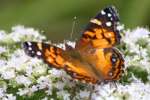 |
- Identification: Upperside with uneven brown, yellow, and orange pattern. Forewing with a black apical patch, a small white spot in the orange field below the patch, and a white bar at the leading edge of the forewing. Underside of hindwing with two large eyespots. Winter form is smaller and paler, summer form larger with brighter coloring.
- Life history: During the afternoon, males perch on hilltops or on low vegetation if there are no hills. Females lay eggs singly on the top of host plant leaves. Caterpillars are solitary, living and feeding in a nest of leaves tied with silk. Adults hibernate.
- Flight: Three to four broods from May-November, all year in the Deep South and South Texas. It is not known if adults can survive very cold winters; the East may have to be recolonized each year by southern migrants.
- Wing span: 1 3/4 - 2 5/8 inches (4.5 - 6.7 cm).
- Caterpillar hosts: Plants in the sunflower family everlasting (Gnaphalium obtusifolium), pearly everlasting (Anaphalis margaritacea), plantain-leaved pussy toes (Antennaria plantaginifolia), wormwood (Artemisia), ironweed (Vernonia), and burdock (Arctium).
- Adult food: Flower nectar almost exclusively, including dogbane, aster, goldenrod, marigold, selfheal, common milkweed, and vetch.
- Habitat: Open places with low vegetation including dunes, meadows, parks, vacant lots, forest edges.
- Range: Resident in the southern United States, Mexico, and Central America south to Colombia. Migrates to and temporarily colonizes the northern United States, southern Canada, the West Indies, and Europe. Rare stray to Newfoundland and Labrador.

|
American Snout Butterfly
Subfamily Libytheinae
Libytheana carinenta
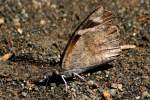
|
- Identification: Labial palps long and extended forward. Tip of forewing squared off. Upperside brown, forewing with orange at base and inner margin, and white spots on outer half. Underside of hindwing mottled or smooth violet-gray.
- Life history: Adults perch on branches and imitate dead leaves by holding palps and antennae downward to look like petioles. Males patrol near host plants to seek females. Eggs are laid in small groups on leaves of the host tree; caterpillars eat young leaves. Adults overwinter in the southern part of their range.
- Flight: Two broods; May-June, and August. These butterflies sometimes undertake huge migrations.
- Wing span: 1 3/8 - 2 inches (3.5 - 5 cm).
- Caterpillar hosts: Several species of hackberry (Celtis).
- Adult food: Nectar from flowers of aster, dogbane, dogwood, goldenrod, sweet pepperbush, and others.
- Habitat: Forest clearings and edges, thorn scrub, brushy fields, roadsides.
- Range: Argentina north through Mexico and the West Indies to southern United States. Migrates to central California, southern Nevada, Colorado, and most of the eastern United States.

|
Buckeye Butterfly
Subfamily Nymphalinae
Junonia coenia
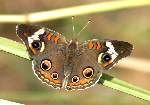 |
- Identification: Upperside is brown. Forewing with 2 orange cell bars and 2 eyespots; part of white subapical band appears in the largest, lower eyespot. Hindwing has 2 eyespots; upper one is largest and contains a magenta crescent. Underside of hindwing is brown or tan in the wet season (summer) form and rose-red in the dry season (fall) form.
- Life history: Males perch during the day on low plants or bare ground to watch for females, flying periodically to patrol or to chase other flying insects. Females lay eggs singly on leaf buds or on upperside of host plant leaves. Caterpillars are solitary and eat leaves. Caterpillars and adults overwinter but only in the south.
- Flight: Two to three broods from May-October, throughout the year in the Deep South.
- Wing span: 1 5/8 - 2 3/4 inches (4.2 - 7 cm).
- Caterpillar hosts: Plants from the snapdragon family including snapdragon (Antirrhinum) and toadflax (Linaria); the plantain family including plantains (Plantago); and the acanthus family including ruellia (Ruellia nodiflora).
- Adult food: Favorite nectar sources are composites including aster, chickory, gumweed, knapweed, and tickseed sunflower. Dogbane, peppermint, and other flowers are also visited.
- Habitat: Open, sunny areas with low vegetation and some bare ground.
- Range: Resident in the southern United States and north along the coasts to central California and North Carolina; south to Bermuda, Cuba, Isle of Pines, and southern Mexico. Adults from the south's first brood migrate north in late spring and summer to temporarily colonize most of the United States and parts of southern Canada. Comments: The eyespots may be used to scare away predators.

|
Carolina Satyr Butterfly
Subfamily Satyrinae
Hermeuptychia sosybius
 |
- Identification: Upperside is brown with no markings. Underside is brown; both wings have many small eyespots rimmed with yellow.
- Life history: Adults have a slow, weak flight, and are usually found flying in the forest understory. Males patrol during the day to find receptive females. Caterpillars eat leaves.
- Flight: Several broods throughout the year in South Texas and the Deep South; three broods from April-October in the northern part of the range.
- Wing span: 1 1/4 - 1 1/2 inches (3.2 - 3.8 cm).
- Caterpillar hosts: Carpet grass (Axonopus compressus), centipede grass (Eremochloa ophiuroides); probably St. Augustine grass (Stenotaphrum secundatum), Kentucky bluegrass (Poa pratensis), and others.
- Adult food: Sap and rotting fruit.
- Habitat: Grassy places and woodlands.
- Range: Southern New Jersey south along the Atlantic Coast to southern Florida; west to southeast Kansas, central Oklahoma, central Texas, and Mexico.

|
|
Creole Pearly-eye Butterfly
Subfamily Satyrinae
Enodia creola
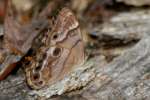
|
- Identification: Male forewing is pointed; upperside is brown with raised patches of dark scales along veins. Underside of both sexes is tan; forewing has a straight submarginal row of 5 spots; dark line along inner side of spot row arches outwardly at the cell.
- Life history: Adults perch on tree trunks during the day, up to 10 feet above ground. Males perch and wait for females in late afternoon or on cloudy days. Females lay eggs singly on or near the host plants; caterpillars feed on leaves at night and hide at the base of the plant during the day. Caterpillars hibernate.
- Flight: Two broods in the north from June-September, three broods in the south from April-September.
- Wing span: 2 5/16 - 2 3/4 inches (5.9 - 7 cm).
- Caterpillar hosts: Switch cane (Arundinaria tecta) in the grass family (Poaceae).
- Adult food: Rotting fruit, sap, dung, carrion; never flower nectar.
- Habitat: Dense moist woods near large swamps, dense upland forests in the southern Appalachians.
- Range: Southeastern states from North Carolina and central Georgia west to eastern Oklahoma and eastern Texas. Does not occur in southeast Alabama, southern Georgia, or Florida.

|
|
Eastern Comma Butterfly
Subfamily Nymphalinae
Polygonia comma
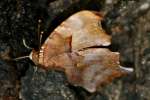
|
- Identification: Small with short hindwing projections. Forewing above is brownish-orange with dark spots; one dark spot at center of bottom edge. Hindwing above has two patterns: summer form is mostly black, winter form is orange with black spots; both have a dark border containing pale spots. Underside is brown; hindwing with a central silver or white comma which is swollen at both ends.
- Life history: Males perch on leaves or tree trunks to watch for females, flying aggressively to chase other insects or even birds. Eggs are laid singly or in stacks under host plant leaves or stems. Caterpillars are usually solitary and feed on leaves at night. Older caterpillars make daytime shelters by pulling leaf edges together with silk. Winter form adults hibernate, some first migrating to the south.
- Flight: Overwintered adults fly and lay eggs in the spring until the end of April. The summer form emerges and flies from May-September, laying eggs that develop into the winter form. These adults appear in September or October and soon seek shelter in which to overwinter.
- Wing span: 1 3/4 - 2 1/2 inches (4.5 - 6.4 cm).
- Caterpillar hosts: All members of the elm and nettle families including American elm (Ulmus americana), hops (Humulus), nettle (Urtica), false nettle (Boehmeria cylindrica), and wood nettle (Laportea canadensis).
- Adult food: Rotting fruit and tree sap.
- Habitat: Deciduous woodlands; woods near rivers, marshes, swamps, and other water sources.
- Range: Eastern half of the United States east of the Rocky Mountains from southern Canada to central Texas and the Gulf Coast.

|
Gemmed Satyr Butterfly
Subfamily Satyrinae
Cyllopsis gemma
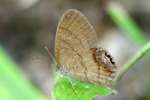 |
- Identification: Wings are brown and lack eyespots. Underside of hindwing has a silvery patch at the outer margin which contains 4 black reflective spots.
- Life history: Males patrol for receptive females. Eggs are laid on or near the host plant. Caterpillars feed at night and hide at the base of the plant during the day. Fourth-stage caterpillars hibernate.
- Flight: Several broods all through the year in South Texas; three broods from April-September elsewhere.
- Wing span: 1 3/8 - 1 11/16 inches (3.5 - 4.3 cm).
- Caterpillar hosts: Probably Bermuda grass (Cynodon dactylon).
- Adult food: Not reported.
- Habitat: Near open, wet woodland; grassy areas near water; near streams and ponds.
- Range: Southeastern United States south to central peninsular Florida; west to southeast Kansas, central Oklahoma, central Texas, and northeastern Mexico.

|
Goatweed Leafwing Butterfly
Subfamily Charaxinae
Anaea andria
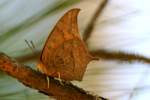
|
- Identification: Underside looks like a dead leaf. Male summer form is dull red with a barely hooked forewing tip, and a short tail on the hindwing. Male winter form is redder with more dark markings, a definitely hooked forewing tip, and a longer tail than the summer form. Both female forms are lighter red and have an irregular yellow submarginal band. The winter female form has hooked forewing tips.
- Life history: Flight is swift, strong, and erratic. Males perch in clearings or on ridgetops to wait for females. Eggs are laid singly under host plant leaves; caterpillars eat leaves. A caterpillar changes shelters as it grows: first it perches on a leaf midvein, then lives in the shelter of a folded leaf, and finally rests in a rolled-up leaf. Adults hibernate, then mate in the spring.
- Flight: The winter form flies from August-May, the summer form from July-August.
- Wing span: 2 3/8 - 3 1/4 inches (6 - 8.2 cm).
- Caterpillar hosts: Goatweed (Croton capitatum), Texas croton (C. texensis), and prairie tea (C. monanthogynus); all in the spurge family (Euphorbiaceae).
- Adult food: Sap, rotting fruit, dung, bird droppings.
- Habitat: Deciduous woods and scrub, especially along waterways; open fields, roadsides, railroad tracks, and other places.
- Range: Eastern Wyoming and eastern Colorado south to New Mexico, Arizona, and Texas; east to Michigan, South Carolina, Virginia, and the Gulf States.

|
Gulf Fritillary Butterfly
Subfamily Heliconiinae
Agraulis vanillae
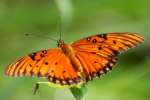 |
- Identification: Upperside bright orange with black markings; 3 black-encircled white dots on forewing leading edge. Underside brown; forewing with orange at base; both wings with elongated, iridescent silver spots.
- Life history: Males patrol for females, who lay eggs on many parts of the host plant. Caterpillars feed on most parts of the host. Adults overwinter in the south.
- Flight: Throughout the year in south Florida and South Texas, January-November in the north. Number of broods has not been determined.
- Wing span: 2 1/2 - 3 3/4 inches (6.3 - 9.5 cm).
- Caterpillar hosts: Various species of passion-vine including maypops (Passiflora incarnata) and running pop (P. foetida).
- Adult food: Nectar from lantana, shepherd\'s needle, cordias, composites, and others.
- Habitat: Pastures, open fields, second-growth subtropical forest and edges, city gardens.
- Range: South America north through Central America, Mexico, and the West Indies to the southern United States. Wanders north to the central United States; rare northward.

|
Hackberry Emperor Butterfly
Subfamily Apaturinae
Asterocampa celtis
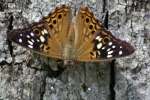 |
- Identification: Extremely variable geographically. Upperside is reddish brown. Forewing has 1 submarginal eyespot, a jagged row of white spots, and the cell has 1 solid black bar and 2 separate black spots.
- Life history: Hackberry Butterflies fly in a fast and erratic manner, and rest upside down on tree trunks. Males perch on tall objects in sunny areas to watch for females. Eggs are laid in clusters, and the young caterpillars feed communally. Caterpillars overwinter in groups gathered inside dead rolled leaves.
- Flight: Two broods from May-October.
- Wing span: 1 3/8 - 2 1/2 inches (3.5 - 6.3 cm).
- Caterpillar hosts: Various hackberries (Celtis species) and sugarberry (Celtis laevigata).
- Adult food: Sap, rotting fruit, dung, carrion. Will take moisture at wet spots along roads and streams.
- Habitat: Along wooded streams, forest glades and river edges, wooded roadsides, towns.
- Range: Resident in most of the eastern United States, central Plains states, and the southwest mountains; northern Mexico.

|
Little Wood-satyr Butterfly
Subfamily Satyrinae
Megisto cymela
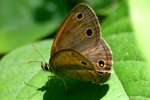 |
- Identification: Light brown. Forewing has 2 yellow-rimmed black eyespots both above and below. Hindwing has 2 eyespots on upper side; but may have smaller spots below.
- Life history: In the early morning and late afternoon, Little Wood Satyrs bask with their wings open while perched on tree leaves or on leaf litter. Adults have a slow bouncing flight and will rise as far as the tops of tall trees. Males patrol in the shade to find females. Eggs are laid singly on grass blades. Fourth-stage caterpillars hibernate.
- Flight: One brood from June-July in the north; two to three broods from March-September in the south.
- Wing span: 1 1/2 - 1 7/8 inches (3.8 - 4.8 cm).
- Caterpillar hosts: Orchard grass (Dactylis glomerata) and centipede grass (Eremochloa ophiuroides).
- Adult food: Sap, aphid honeydew, and rarely flower nectar.
- Habitat: Grassy woods and openings, old fields; especially in limey or basic soils.
- Range: Eastern Nebraska and northeastern Colorado south to eastern Texas; east through all of the eastern United States except northern New England, southern peninsular Florida, and coastal Louisiana.

|
Monarch Butterfly
Subfamily Danainae
Danaus plexippus
 |
- Identification: Upperside of male is bright orange with wide black borders and black veins; hindwing has a patch of scent scales. Upperside of female is orange-brown with wide black borders and blurred black veins. Both sexes have white spots on borders and apex.
- Life history: Adults warm up by basking dorsally (with their wings open and toward the sun). Females lay eggs singly under the host leaves; caterpillars eat leaves and flowers. Adults make massive migrations from August-October, flying thousands of miles south to hibernate along the California coast and in central Mexico. A few overwinter along the Gulf coast or south Atlantic coast. Along the way, Monarchs stop to feed on flower nectar and to roost together at night. At the Mexico wintering sites, butterflies roost in trees and form huge aggregations that may have millions of individuals. During the winter the butterflies may take moisture and flower nectar during warm days. Most have mated before they leave for the north in the spring, and females lay eggs along the way. Residents of tropical areas do not migrate but appear to make altitude changes during the dry season.
- Flight: In North America during spring and summer there may be 1-3 broods in the north and 4-6 broods in the south. May breed all year in Florida, South Texas, and southeastern California.
- Wing span: 3 3/8 - 4 7/8 inches (8.6 - 12.4 cm).
- Caterpillar hosts: Milkweeds including common milkweed (Asclepius syriaca), swamp milkweed (A. incarnata), and showy milkweed (A. speciosa); and milkweed vine in the tropics. Most milkweeds contain cardiac glycosides which are stored in the bodies of both the caterpillar and adult. These poisons are distasteful and emetic to birds and other vertebrate predators. After tasting a Monarch, a predator might associate the bright warning colors of the adult or caterpillar with an unpleasant meal, and avoid Monarchs in the future.
- Adult food: Nectar from all milkweeds. Early in the season before milkweeds bloom, Monarchs visit a variety of flowers including dogbane, lilac, red clover, lantana, and thistles. In the fall adults visit composites including goldenrods, blazing stars, ironweed, and tickseed sunflower.
- Habitat: Many open habitats including fields, meadows, weedy areas, marshes, and roadsides.
- Range: Southern Canada south through all of the United States, Central America, and most of South America. Also present in Australia, Hawaii, and other Pacific Islands. Comments: The Viceroy butterfly (Limenitis archippus) is edible, but mimics the poisonous Monarch in order to gain protection from predators.

|
Mourning Cloak Butterfly
Subfamily Nymphalinae
Nymphalis antiopa
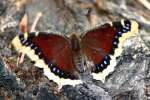 |
- Identification: Short projections on both wings, borders irregular. Upperside is purple-black with a wide, bright yellow border on outer margins, and a row of iridescent blue spots at the inner edge of the border.
- Life history: Overwintered adults mate in the spring, the males perching in sunny openings during the afternoon to wait for receptive females. Eggs are laid in groups circling twigs of the host plant. Caterpillars live in a communal web and feed together on young leaves, then pupate and emerge as adults in June or July. After feeding briefly, the adults estivate until fall, when they re-emerge to feed and store energy for hibernation. Some adults migrate south in the fall.
- Flight: Usually one flight from June-July.
- Wing span: 2 1/4 - 4 inches (5.7 - 10.1 cm).
- Caterpillar hosts: Willows including black willow (Salix nigra), weeping willow (S. babylonica), and silky willow (S. sericea); also American elm (Ulmus americana), cottonwood (Populus deltoides), aspen (P. tremuloides), paper birch (Betula papyrifera), and hackberry (Celtis occidentalis). Older caterpillars wander about and may be found on plants that they do not eat.
- Adult food: Mourning Cloaks prefer tree sap, especially that of oaks. They walk down the trunk to the sap and feed head downward. They will also feed on rotting fruit, and only occasionally on flower nectar.
- Habitat: Because Mourning Cloaks roam and migrate, they are found almost anywhere that host plants occur including woods, openings, parks, and suburbs; and especially in riparian areas.
- Range: All of North America south of the tundra to central Mexico; rarely in the Gulf States and peninsular Florida. Also native to temperate Eurasia. Comments: Adults live 10-11 months and may be our longest lived butterfly.

|
Painted Lady Butterfly
Subfamily Nymphalinae
Vanessa cardui
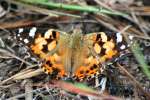 |
- Identification: Upperside is orange-brown with darker wing bases; forewing with black apex patch and white bar on leading edge; hindwing submarginal row of 5 small black spots sometimes has blue scales. Underside has a black, brown, and gray pattern with 4 small submarginal eyespots.
- Life history: Males perch and patrol during the afternoon for receptive females. In the West males usually perch on shrubs on hilltops, while in the East males perch on bare ground in open areas. Females lay eggs singly on the tops of host plant leaves. Caterpillars live in silk nests and eat leaves. Adults hibernate only in the South and in mild winters.
- Flight: One to three flights in the East from May-October, three to four flights in South Texas from October-April.
- Wing span: 2 - 2 7/8 inches (5.1 - 7.3 cm).
- Caterpillar hosts: More than 100 host plants have been noted; favorites include thistles (Asteraceae), hollyhock and mallow (Malvaceae), and various legumes (Fabaceae).
- Adult food: The Painted Lady prefers nectar from composites 3-6 feet high, especially thistles; also aster, cosmos, blazing star, ironweed, and joe-pye weed. Flowers from other families that are visited include red clover, buttonbush, privet, and milkweeds.
- Habitat: Almost everywhere, especially in open or disturbed areas including gardens, old fields, dunes.
- Range: On all continents except Australia and Antarctica. From the deserts of northern Mexico, the Painted Lady migrates and temporarily colonizes the United States and Canada south of the Arctic. Occasionally, population explosions in Mexico will cause massive northward migrations. Comments: The Painted Lady is also known as the Thistle Butterfly because of the caterpillars' food preference and also as the Cosmopolitan because it is the most widely distributed butterfly in the world.

|
Pearl Crescent Butterfly
Subfamily Nymphalinae
Phyciodes tharos
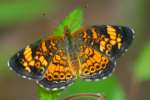 |
- Identification: Quite variable. Males usually have black antennal knobs. Upperside is orange with black borders; postmedian and submarginal areas are crossed by fine black marks. Underside of hindwing has a dark marginal patch containing a light-colored crescent. Spring and fall broods (form marcia) have a gray mottled hindwing below.
- Life history: Males patrol open areas for females. Eggs are laid in small batches on underside of host plant leaves. Caterpillars eat leaves and are gregarious when young. Hibernation is by third-stage caterpillars.
- Flight: Several broods; from April-November in the north, throughout the year in the Deep South and Mexico.
- Wing span: 1 1/4 - 1 3/4 inches (3.2 - 4.5 cm).
- Caterpillar hosts: Several species of smooth-leaved true asters including Aster pilosus, A. texanus, and A. laevis.
- Adult food: Nectar from a great variety of flowers including dogbane, swamp milkweed, shepherd's needle, asters, and winter cress.
- Habitat: Open areas such as pastures, road edges, vacant lots, fields, open pine woods.
- Range: Southeastern Alberta south through Montana, Wyoming, Colorado, New Mexico, Arizona, and southeastern California to Mexico; east to southern Ontario and all the eastern United States.

|
Phaon Crescent Butterfly
Subfamily Nymphalinae
Phyciodes phaon
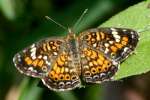 |
- Identification: Forewing is dark orange and black with a pale cream median band. Underside of hindwing is cream to yellowish; spring and fall butterflies (form marcia) have a gray hindwing.
- Life history: Males patrol during daytime near the host plant. Eggs are laid in small groups on underside of host plant leaves; caterpillars eat leaves.
- Flight: Many broods southern Florida; February-October in California; April-September in New Mexico.
- Wing span: 1 - 1 1/2 inches (2.5 - 3.8 cm).
- Caterpillar hosts: Fogfruit (Lippia lanceolata) and mat grass (Lippia nodiflora) in the verbena family.
- Adult food: Nectar from flowers of Lippia and composites including shepherd's needle.
- Habitat: Openings in thorn forest, open areas with closely cropped plants, dunes, pastures, road edges.
- Range: Guatemala north through Cuba and Mexico to southern California, east through South Texas and Florida to coastal South Carolina. Strays to eastern Colorado, Nebraska, Kansas, and Missouri.

|
|
Question Mark Butterfly
Subfamily Nymphalinae
Polygonia interrogationis
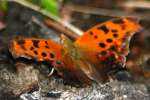
|
- Identification: Forewing hooked; upperside is red-orange with black spots. Upperside hindwing of summer form is mostly black with a short tail; that of winter form has much orange and a longer, violet-tipped tail. Underside is light brown; hindwing with pearly white question mark in center.
- Life history: Males find females by perching on leaves or tree trunks in the afternoon, flying to chase other insects and even birds. Females lay eggs singly or stacked under leaves of plants that are usually not the hosts. Caterpillars must find a host plant; they then eat leaves and live alone. Adults of the winter form hibernate; some staying in the north, many migrating to the south.
- Flight: Overwintered adults fly and lay eggs in the spring until the end of May. The summer form emerges and flies from May-September, laying eggs that develop into the winter form; these adults appear in late August and spend the winter in various shelters.
- Wing span: 2 1/4 - 3 inches (5.7 - 7.6 cm).
- Caterpillar hosts: American elm (Ulmus americanus), red elm (Ulmus rubra), hackberry (Celtis), Japanese hop (Humulus japonicus), nettles (Urtica), and false nettle (Boehmeria cylindrica).
- Adult food: Rotting fruit, tree sap, dung, carrion. Only when these are unavailable do Question Marks visit flowers such as common milkweed, aster, and sweet pepperbush.
- Habitat: Wooded areas with some open space, city parks, suburbs, fencerows.
- Range: Southern Canada and all of the eastern United States except peninsular Florida, west to the eastern edge of the Rocky Mountains, south to southern Arizona and Mexico.

|
Red Admiral Butterfly
Subfamily Nymphalinae
Vanessa atalanta
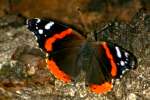 |
- Identification: Upperside is black with white spots near the apex; forewing with red median band, hindwing with red marginal band. The winter form is smaller and duller, summer form larger and brighter with an interrupted forewing band.
- Life history: The Red Admiral has a very erratic, rapid flight. Males perch, on ridgetops if available, in the afternoon to wait for females, who lay eggs singly on the tops of host plant leaves. Young caterpillars eat and live within a shelter of folded leaves; older caterpillars make a nest of leaves tied together with silk. Adults hibernate.
- Flight: Two broods from March-October in the north, winters from October-March in South Texas.
- Wing span: 1 3/4 - 3 inches (4.5 - 7.6 cm).
- Caterpillar hosts: Plants of the nettle family (Urticaceae) including stinging nettle (Urtica dioica), tall wild nettle (U. gracilis), wood nettle (Laportea canadensis), false nettle (Boehmeria cylindrica), pellitory (Parietoria pennsylvanica), mamaki (Pipturus albidus), and possibly hops (Humulus).
- Adult food: Red Admirals prefer sap flows on trees, fermenting fruit, and bird droppings; visiting flowers only when these are not available. Then they will nectar at common milkweed, red clover, aster, and alfalfa, among others.
- Habitat: Moist woods, yards, parks, marshes, seeps, moist fields. During migrations, the Red Admiral is found in almost any habitat from tundra to subtropics.
- Range: Guatemala north through Mexico and the United States to northern Canada; Hawaii, some Caribbean Islands, New Zealand, Europe, Northern Africa, Asia. Cannot survive coldest winters; most of North America must be recolonized each spring by southern migrants.

|
Red-spotted Purple Butterfly
Subfamily Limenitidinae
Limenitis arthemis astyanax
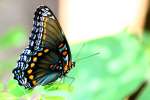 |
- Identification: These two very different forms had once been considered separate species. WHITE ADMIRAL: Upperside is black with broad white median bands on both wings; hindwing has a marginal row of blue dashes and a submarginal row of red dots. Underside is reddish-brown with white median bands as on the upperside. RED-SPOTTED PURPLE: Upperside is blue to blue-green with much iridescence on the outer part of the hindwing. Underside is dark brown. Forewing has 2 red-orange bars near the base of the leading edge; hindwing has 3 red-orange spots near the base and a submarginal row of red-orange spots. The two forms hybridize where their ranges overlap, creating various intermediate forms which may be found in or near the overlap zone.
- Life history: Males perch 3 feet or more above the ground on trees and tall bushes and rarely patrol for females. Eggs are laid singly on tips of host plant leaves; caterpillars eat leaves. Third-stage caterpillars hibernate.
- Flight: Two broods from April-October.
- Wing span: 2 1/4 - 4 inches (5.7 - 10.1 cm).
- Caterpillar hosts: Leaves of many species of trees and shrubs including wild cherry (Prunus), aspen, poplar, cottonwood (Populus), oaks (Quercus), hawthorn (Crataegus), deerberry (Vaccinium stamineum), birch (Betula), willows (Salix), basswood (Tilia), and shadbush (Amelanchier).
- Adult food: Sap flows, rotting fruit, carrion, dung, and occasionally nectar from small white flowers including spiraea, privet, and viburnum. White Admirals also sip aphid honeydew.
- Habitat: The White Admiral form is usually found in the north in deciduous broad-leaf or mixed evergreen forests dominated by aspen or birch. The Red-Spotted Purple form is usually found further south than the White Admiral, in deciduous or mixed forests, moist uplands, valley bottoms, and coastal plains.
- Range: Alaska and subarctic Canada southeast of the Rocky Mountains to central Texas; east to New England and central Florida. Isolated populations in Arizona, New Mexico, and west Texas south into Mexico. The White Admiral form usually occurs north of a line through north central New England, New York, Pennsylvania, Michigan, and Minnesota. The Red-spotted Purple form is usually found south of this line. Much hybridization occurs where these forms meet. Comments: The Red-spotted Purple is a mimic of the poisonous Pipevine Swallowtail (Battus philenor).

|
Southern Pearly-eye Butterfly
Subfamily Satyrinae
Enodia portlandia
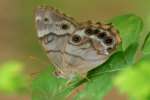
|
- Identification: Antennal clubs are orange. Upperside is brown with dark eyespots at the margins. Underside is light brown; submarginal row of 4 spots (Florida females may have 5) on forewing is slightly curved and brown line inside this spot row is straight or zigzagged. Spots are encircled by diffuse white.
- Life history: Males perch on tree trunks, sometimes head downward, to wait for females. Eggs are laid singly on or near the host plant; caterpillars feed on leaves. Older caterpillars hibernate.
- Flight: Three broods from March-October.
- Wing span: 2 3/16 - 2 3/4 inches (5.6 -7 cm).
- Caterpillar hosts: Bamboo switch cane (A. tecta).
- Adult food: Sap, rotting fruit, carrion, dung.
- Habitat: Shady, damp woods near stream-fed swamps.
- Range: Eastern Oklahoma and eastern Texas east through the southeastern United States.

|
Variegated Fritillary Butterfly
Subfamily Heliconiinae
Euptoieta claudia
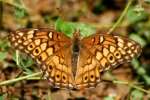 |
- Identification: Upperside tawny orange with thick dark veins and markings; black spots near margin. Hindwing margin angled and slightly scalloped. Underside of hindwing with a mottled pattern and no silver spots.
- Life history: Males patrol short distances in flat, dry, open places. Eggs are laid singly on host plant stems and leaves; caterpillars eat leaves and flowers.
- Flight: Three broods from April-October in the north, four broods from February or March-November or December in the south.
- Wing span: 1 3/4 - 3 1/8 inches (4.5 - 8 cm).
- Caterpillar hosts: A variety of plants in several families including maypops (Passiflora incarnata), may apple (Podophyllum peltata), violets (Viola), purslane (Portulaca), stonecrop (Sedum), and moonseed (Menispermum).
- Adult food: Nectar from several plant species including butterflyweed, common milkweed, dogbane, peppermint, red clover, swamp milkweed, and tickseed sunflower.
- Habitat: Open sunny areas such as prairies, fields, pastures, road edges, landfills.
- Range: Higher elevations of Argentina through Central America and Mexico to the southern United States; also Cuba and Jamaica. Regularly colonizes north through most of the United States except the Pacific Northwest.

|
Viola's Wood-satyr
Subfamily Satyrinae
Megisto viola
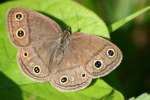 |
- Identification: Light brown. Upperside has 2 large eyespots on each wing. Underside of both wings has distinct markings; the dark postmedian line is strongly bowed.
- Life history: Adults have a slow bouncing flight and will rise as far as the tops of tall trees. Males patrol in the shade to find females. Eggs are laid singly on grass blades, which the caterpillars eat.
- Flight: One flight; April in Florida, later elsewhere.
- Wing span: 1 11/16 - 1 15/16 inches (4.3 - 5 cm).
- Caterpillar hosts: Orchard grass (Dactylis glomerata) and centipede grass (Eremochloa ophiuroides).
- Adult food: Sap, aphid honeydew, rarely flower nectar.
- Habitat: Grassy woods.
- Range: Along the Atlantic Coast from South Carolina south to central Florida. The range is probably larger, but is not well-defined.

|
| Information / Identification Sources: |
For identification our primary reference is Butterflies of North America - Kaufman Focus Guides - by Jim P. Brock & Ken Kaufman. We also use internet sources when in question - typically BugGuide and Jeff's Butterfly Page. Our text information (above) comes from Butterflies & Moths of North America. |
|


